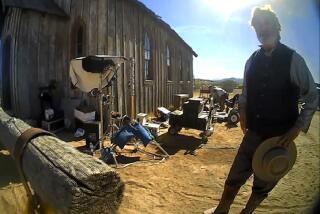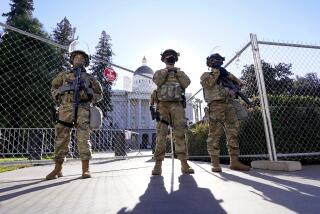Weinberger Kills Anti-Aircraft Gun : After $1.8 Billion, He Says Sgt. York Is Ineffective, Not Worth Further Cost
- Share via
WASHINGTON — After a Pentagon investment of $1.8 billion, Defense Secretary Caspar W. Weinberger on Tuesday killed the Army’s controversial Sgt. York air defense gun, saying it is “not worth the additional cost” to proceed with a weapon that tests have found “not adequately effective in protecting friendly forces.”
The unusual turnabout occurred after months of debate and after the Ford Aerospace & Communications Corp. had already delivered 65 of the 618 guns, which the Army once planned to make the mainstay of its defenses against missile-firing helicopters and low-flying planes.
Weinberger made the announcement at a crowded news conference after a personal review of three rounds of tests ordered earlier this year. The Army had asked him to approve $417.5 million for 117 more of the weapons, but Weinberger had put the request on hold until his most recent evaluation was completed.
‘Growing Military Threat’
Saying that the much-debated division air defense gun--often referred to as DIVAD--”does not effectively meet the growing military threat,” Weinberger declared: “We will not invest any more funds in this system.”
He noted that the “the problems with the system in no way reduce the Army’s very urgent need for better air defense.”
In formally notifying Congress of his evaluation, Weinberger reported that the Sgt. York not only failed to demonstrate that it could protect friendly forces in simulated combat but that it also showed it was “not operationally suitable.”
The weapon’s longtime critics hailed the decision as vindication of their position that the gun was ineffective and inadequately tested by the Army.
Rep. Denny Smith (R-Ore.), one of the weapon’s most persistent opponents, said: “It took a lot of guts to terminate DIVAD. Weapons systems, especially those that are this far along, develop a life of their own, making it all the more difficult to stop even the bad ones.”
The Army, seeking to defend against an increasingly sophisticated threat from helicopters and close air support fighters, believed that in the Sgt. York it had found a high-technology solution incorporating components of proven weapons systems.
Work on the weapon began in 1977, and Ford Aerospace & Communications Corp. of Newport Beach, Calif., was selected as its prime contractor in March, 1981. The first gun came off the assembly line in Orange County in September, 1983, and the Defense Department has spent $1.8 billion on the system.
Each weapon consisted of two Swedish-made 40-millimeter cannons mounted on the chassis of an M-48 tank and employing the same radar system used by the F-16 fighter plane. With laser range finders and computer-controlled guidance, it was supposed to quickly bring high-performance targets under lethal attack.
However, the Sgt. York reportedly functioned poorly in either extremely hot or cold weather and sometimes “locked” onto buildings rather than moving targets. In recent live-fire tests, the Army and Ford Aerospace contended that it destroyed six of seven remotely controlled jet planes as well as three helicopters, but critics insisted that the tests fell far short of a realistic simulation of combat conditions.
Prepares Final Review
Even as Weinberger prepared his final review of the gun’s performance, Smith and other critics argued that the weapon was flawed critically and that the live-fire tests, conducted at White Sands Missile Range in New Mexico, had been neither realistic nor impressive.
From the outset, the Army had sought to keep the project on schedule and to work its way through the technical problems, although the Pentagon more than a year ago warned the contractor that it had found “totally unacceptable contract performance.”
On Tuesday, Weinberger said “marginal improvements” in the weapon were still possible. But he argued that this would not make the Sgt. York’s performance significantly better than the Vulcan Gatling gun and the Chaparral and Stinger missile systems now used in air defense.
“What went wrong,” he said of the canceled DIVAD, “was that the system did not develop the capabilities that we require, and those capabilities depend upon the growing nature of the Soviet threat--specifically, the ability of the helicopter to sit off and stand off and deliver very effective fire against combat troops.”
Effort on Ground Forces
The Sgt. York was designed primarily to defend tanks and other ground forces against air attack. Weinberger emphasized that an effort also will be launched to improve such forces.
“I am directing the secretary of the Army and the undersecretary of defense for research and engineering to seek a solution for a very real and urgent divisional air defense need in the very shortest possible time,” he said.
In applauding the decision to terminate the Sgt. York, named for the World War I hero Alvin York, Smith agreed with Weinberger that another weapon is needed.
“It is important now for the Army to move forward with a simple, reliable, low-cost anti-aircraft gun that requires low maintenance and low-cost ammunition,” Smith said in a statement released in Oregon. “Just as important on the next go-round, we need realistic tests to prove that the DIVAD replacement is an effective tool in protection of our fighting men.”
Smith gave special credit for the decision to drop the Sgt. York to John E. Krings of the Defense Department’s Independent Office of Test and Evaluation. In a letter to Smith after the live-fire tests of the Sgt. York, the Pentagon’s chief weapons tester acknowledged that congressional concerns over the validity of the tests were justified.
Scrubbing a major weapons program is unusual but not unprecedented. Part IV, Page 1.
More to Read
Sign up for Essential California
The most important California stories and recommendations in your inbox every morning.
You may occasionally receive promotional content from the Los Angeles Times.













